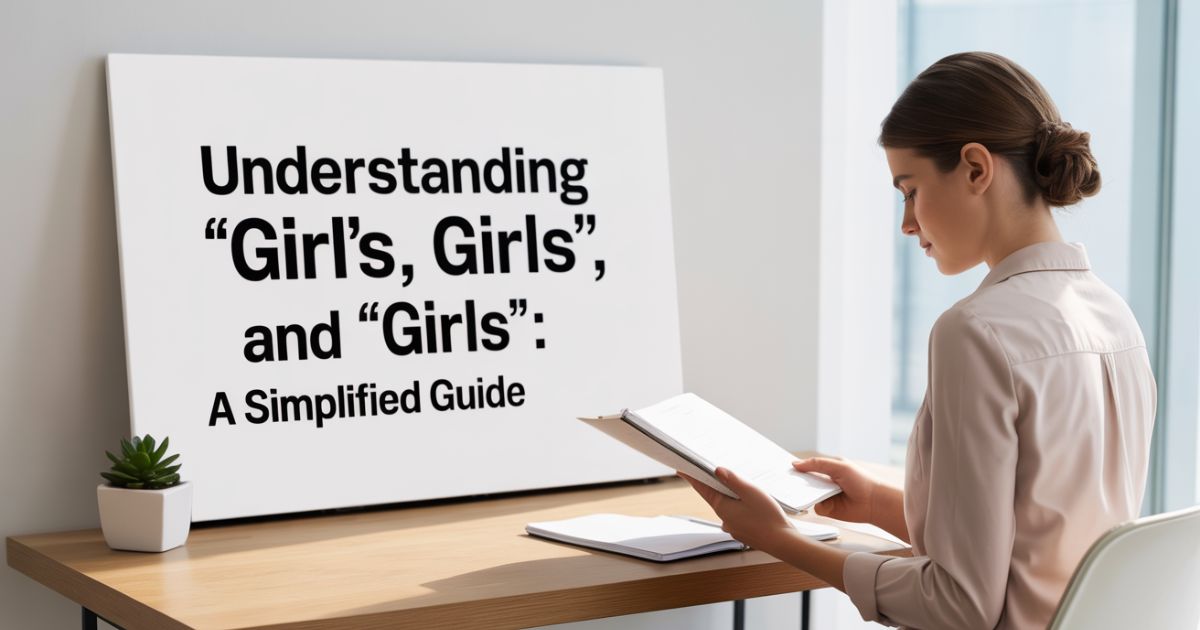English can be confusing even for native speakers. One of the most common sources of confusion comes from possessive nouns and plural forms that look and sound similar. Today, we’re going to break down the differences between “Girl’s,” “Girls’,” and “Girls” in a way that’s simple, clear, and practical.
Let’s face it, punctuation marks like apostrophes can be tricky. Just one little mark can completely change the meaning of a word. So if you’ve ever wondered whether to write “girl’s book,” “girls’ room,” or just “girls playing”, you’re definitely not alone.
The Basics: What Do These Forms Mean?
Before we go into examples, here’s a quick breakdown:
- Girl’s – Singular possessive (something belongs to one girl)
- Girls’ – Plural possessive (something belongs to more than one girl)
- Girls – Plural (more than one girl, no possession involved)
These are all variations of the same base word: girl. But the apostrophe—or the lack of it—plays a big role in how each word functions in a sentence.
Girl’s – Possession by One Girl
When you see “girl’s” with the apostrophe before the “s,” it’s showing that one girl owns or is associated with something.
🔹 Scenario Example:
Let’s say Sarah has a backpack.
“That is the girl’s backpack.”
Here, we’re referring to one girl Sarah and the backpack that belongs to her.
🔹 More Examples:
- “The girl’s bicycle is pink.” (One girl owns the bicycle.)
- “I found the girl’s notebook on the table.” (One girl left her notebook.)
- “The girl’s voice echoed through the hallway.” (The voice of one girl.)
Think of “girl’s” as the same idea as “the backpack of the girl.” It’s just more natural and concise.
Girls’ – Possession by More Than One Girl
This is where it gets tricky. When you put the apostrophe after the “s,” like this: “girls’,” it means you’re talking about something that belongs to more than one girl.
🔹 Scenario Example:
Imagine there are three sisters who share a bedroom.
“This is the girls’ room.”
The room belongs to all three girls—not just one. So the apostrophe comes after the “s” to show that multiple girls are involved.
🔹 More Examples:
- “The girls’ soccer team won the tournament.” (The team of many girls.)
- “We visited the girls’ dormitory during the campus tour.” (A dorm shared by several girls.)
- “All of the girls’ bags were placed in a corner.” (Bags that belong to multiple girls.)
A good trick is to ask yourself: Is it more than one girl? If yes, and something belongs to them, use “girls’.”
Girls – Just the Plural Form (No Possession)
This is the simplest form. No apostrophes, no possession. Just the plural of “girl.”
Use “girls” when you are simply referring to more than one girl, and nobody owns anything.
🔹 Scenario Example:
You’re watching a group of kids playing at the park.
“The girls are playing on the swings.”
In this case, you’re just describing what they are doing. Nothing belongs to them in this sentence.
🔹 More Examples:
- “Three girls joined the science club.” (Just saying who joined.)
- “The girls laughed together.” (Talking about their action, not something they own.)
- “I saw two girls reading in the library.” (Again, no possession.)
No apostrophe = no ownership. Just a plain plural noun.
Let’s Compare Them Side-by-Side
It can help to see the same object used in different ways. Let’s use the word “shoes” for an easy comparison.
| Sentence | Meaning |
|---|---|
| “The girl’s shoes are red.” | One girl owns the shoes. |
| “The girls’ shoes are red.” | Multiple girls own the shoes. |
| “The girls are wearing red shoes.” | Just describing the girls. No possession. |
Notice how that tiny apostrophe changes the meaning entirely.
How to Avoid Common Mistakes
Many people accidentally use “girl’s” when they mean “girls,” or forget the apostrophe when showing ownership.
Here are a few tips:
✅ Tip #1: Identify How Many Girls
If it’s one girl, and she owns something, use “girl’s.”
If it’s more than one, and they own something, use “girls’.”
If it’s just talking about the girls (no ownership), use “girls.”
✅ Tip #2: Use Substitution
Try rephrasing with “of the girl” or “of the girls” to test it.
- “The girl’s backpack” → “The backpack of the girl” ✅
- “The girls’ room” → “The room of the girls” ✅
If the sentence still makes sense, then your use of the apostrophe is probably correct.
A Few Tricky Situations
🔹 When Context Is Missing
Sometimes the sentence doesn’t clearly tell you how many girls are being referred to.
“I found the girls’ jacket.”
This can be confusing how can multiple girls share one jacket? That’s where context matters. Maybe it’s a team uniform or costume. But if it’s clearly just one jacket for one girl, then it should be:
“I found the girl’s jacket.”
🔹 When Talking in General Terms
If you’re just making a general statement, the plain plural “girls” is usually right.
“Girls tend to enjoy different hobbies.”
(You’re talking about girls in general, not any particular ones.)
Final Thoughts
The difference between “girl’s,” “girls’,” and “girls” comes down to ownership and number. It’s one of those little grammar details that can trip people up, but once you get the hang of it, it becomes second nature.
Here’s a quick summary:
- Use “girl’s” for one girl who owns something.
- Use “girls’” for more than one girl who own something.
- Use “girls” when you’re just talking about multiple girls, not about something they own.
Next time you’re writing and you hit that moment of doubt, just pause and ask yourself:
Is something being owned?
Is it one girl or more than one?
Answer those two questions, and you’ll know exactly which word to use.


